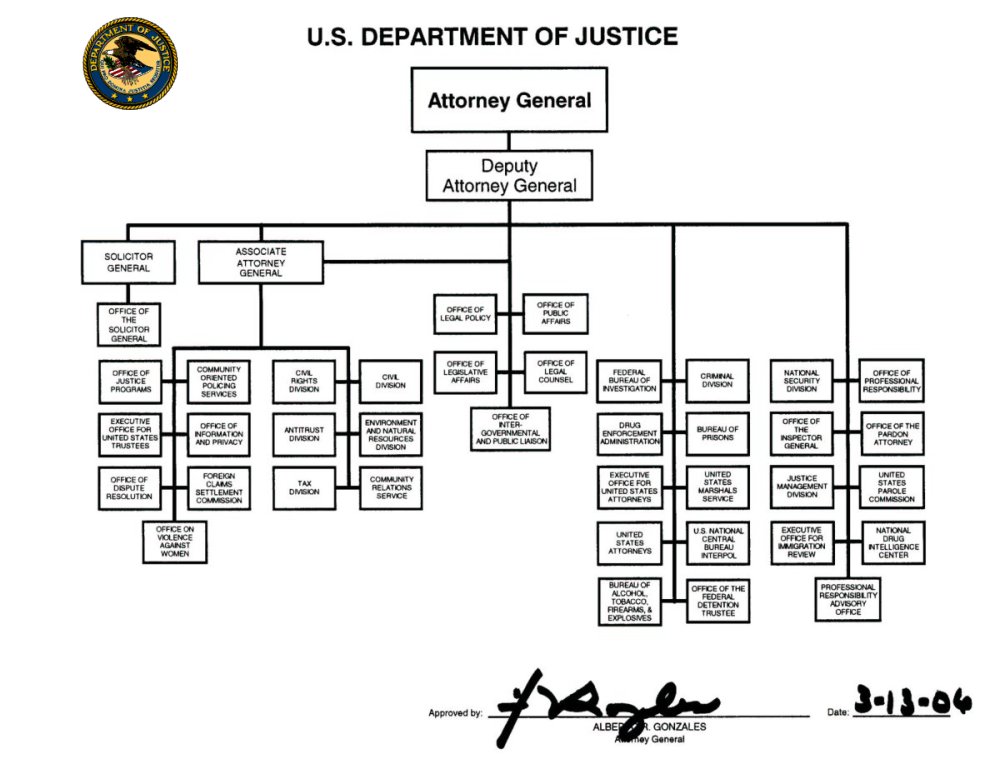 d
d
OFFICE OF THE ATTORNEY GENERAL
The position of Attorney General was created by the Judiciary Act of 1789. In June 1870 Congress enacted a law entitled “An Act to Establish the Department of Justice.” This Act established the Attorney General as head of the Department of Justice and gave the Attorney General direction and control of U.S. Attorneys and all other counsel employed on behalf of the United States. The Act also vested in the Attorney General supervisory power over the accounts of U.S. Attorneys and U.S. Marshals.
The mission of the Office of the Attorney General is to supervise and direct the administration and operation of the Department of Justice, including the Federal Bureau of Investigation, Drug Enforcement Administration, Bureau of Alcohol, Tobacco, Firearms and Explosives, Bureau of Prisons, Office of Justice Programs, and the U.S. Attorneys and U.S. Marshals Service, which are all within the Department of Justice.
The principal duties of the Attorney General are to:
- Represent the United States in legal matters.
- Supervise and direct the administration and operation of the offices, boards, divisions, and bureaus that comprise the Department.
- Furnish advice and opinions, formal and informal, on legal matters to the President and the Cabinet and to the heads of the executive departments and agencies of the government, as provided by law.
- Make recommendations to the President concerning appointments to federal judicial positions and to positions within the Department, including U.S. Attorneys and U.S. Marshals.
- Represent or supervise the representation of the United States Government in the Supreme Court of the United States and all other courts, foreign and domestic, in which the United States is a party or has an interest as may be deemed appropriate.
- Perform or supervise the performance of other duties required by statute or Executive Order.
OFFICE OF THE DEPUTY ATTORNEY GENERAL
On May 24, 1950, Attorney General J. Howard McGrath created the Office of the Deputy Attorney General (ODAG).
The mission of ODAG is to advise and assist the Attorney General in formulating and implementing Department policies and programs and in providing overall supervision and direction to all organizational units of the Department.
The major functions of the DAG are to:
- Exercise all the power and authority of the Attorney General unless any such power or authority is required by law to be exercised by the Attorney General personally or has been specifically delegated exclusively to another Department official.
- Except as assigned to the Associate Attorney General by 28 CFR § 0.19(a)(1), exercise the power and authority vested in the Attorney General to take final action in matters pertaining to:
- The employment, separation, and general administration of personnel in the Senior Executive Service and of attorneys and law students regardless of grade or pay in the Department;
- The appointment of special attorneys and special assistants to the Attorney General (28 U.S.C. 515(b));
- The appointment of Assistant United States Trustees and fixing of their compensation; and
- The approval of the appointment by United States Trustees of standing trustees and the fixing of their maximum annual compensation and percentage fees as provided in 28 U.S.C. 586(e).
- Administer the Attorney General’s recruitment program for honor law graduates and judicial law clerks.
- Coordinate departmental liaison with White House staff and the Executive Office of the President.
- Coordinate and control the Department’s reaction to civil disturbances and terrorism.
- Perform such other activities and functions as may be assigned from time to time by the Attorney General.
OFFICE OF THE ASSOCIATE ATTORNEY GENERAL
The Office of the Associate Attorney General (OASG) was created by Attorney General Order No. 699-77 on March 10, 1977.
As the third-ranking official at the Department of Justice, the AAG is a principal member of the Attorney General’s senior management team.
The major functions of the ASG are to:
- Advise and assist the Attorney General and Deputy Attorney General on the formulation and implementation of Department of Justice policies and programs.
- Supervise the work of the Civil, Civil Rights, Antitrust, Tax, and Environment and Natural Resources Divisions. The ASG also has oversight responsibility for the Office of Justice Programs, the Office of Community Oriented Policing Services, the Office of Tribal Justice, the Office of Dispute Resolution, the Office of Information and Privacy, the Community Relations Service, the Executive Office for United States Trustees, Office on Violence Against Women and the Foreign Claims Settlement Commission.
Return to the table of contents
 d
d